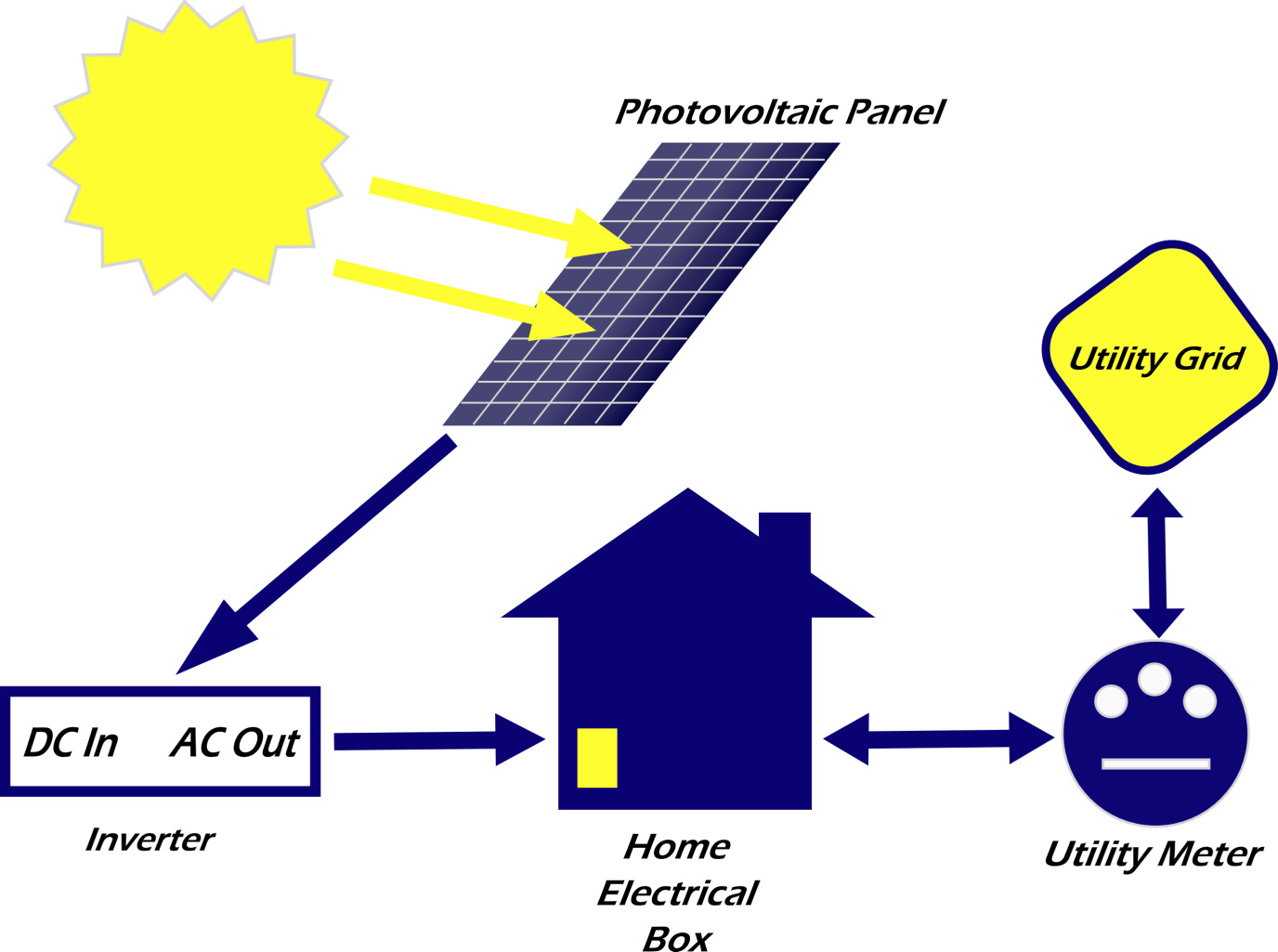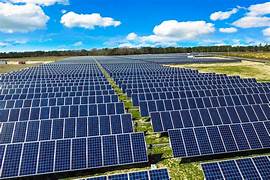Solar Energy Production Process Solor Devices
There are many different types of solar energy systems that will convert the solar resource into a useful form of energy. the solar resource is captured and converted into heat which is then supplied to a demand for thermal energy (thermal load) such as house heating, hot water heating or heat for industrial processes. This type of system may or may not include thermal storage, and usually include an auxiliary source of energy so that the demand may be met during long periods with no sunshine.
The basic resource for all solar energy systems is the sun. Knowledge of the quantity and quality of solar energy available at a specific location is of prime importance for the design of any solar energy system. Although the solar radiation (insolation) is relatively constant outside the earth’s atmosphere, local climate influences can cause wide variations in available insolation on the earth’s surface from site to site. In addition, the relative motion of the sun with respect to the earth will allow surfaces with different orientations to intercept different amounts of solar energy.
Energy production through means of solar energy is the future of world’s energy needs. This free energy from sun can be easily converted into electrical energy to reduce energy costs and provide electricity in remote areas where infrastructure is limited.
Energy Production
A technical overview of the equipment used in a solar electric system.
To select a solar electric system for your home or RV, you should know what the major parts are called, what each one is for, and how they work together. Here is a quick overview explaining the whole process.
The Process
Sun shining on solar panels produces direct current electricity, or DC, the only kind of power stored in batteries. Often this is 12 volt DC, the standard used in cars and RVs. Larger systems may be designed for 24 volt DC, or sometimes 48 volt DC. This just means combining the same solar panels in pairs for 24 volt, or groups of four to get 48 volt. Windmills and micro-hydro generators in this catalog also produce DC for charging batteries.
This DC power is stored in deep cycle lead-acid batteries, which give back the electricity as needed, even when no power is being produced. Like a bank account, power put into batteries over a period of time can be taken out more quickly if a lot is needed. Like a bank account you cannot take out more than you put in, or the account will be depleted. Moreover, lead-acid batteries need to be frequently 100% fully charged to remain in good condition. They should never be drawn completely down to empty. Because of these needs, to get the most years from your batteries requires some supervision by the owner.
The inverter is a major component that converts the 12, 24, or 48 volt DC current from the battery into 120 volt AC current, the same as utility power for standard household lights, outlets, and appliances. Most solar homes use primarily 120 volt AC produced by the inverter. A few DC circuits are usually added where using DC can save a lot of energy. Sometimes a small solar electric RV, boat, or cabin may have no inverter, and use only DC wiring and appliances.
If there are a number of consecutive days without sunshine, the owner, being aware of the weather, checks his batteries. If the charge level is low, an engine driven generator may be started to recharge the batteries in order to keep the whole system working. A battery charger plugs into 120 volt AC from the generator producing low voltage DC to charge the battery. The generator is shut down after the batteries have been recharged. This process is automated in some power systems. Battery chargers in Recreational Vehicles are called converters).
The Hardware
Solar panels
Charge Controller
Batteries
Inverter
Stand By Inverter/Charger
Engine Generator
Fuses or Circuit Breakers
Meters
Power-Centre
Solar panels are installed in groups of 1 to 12 panels on a solar mount, which in turn attaches to a building, to the roof of an RV, or atop a metal post in the yard. Together this is called a solar array. Each solar panel is wired to the other panels in that array by sunlight tolerant solar interconnect wiring. Several arrays may be wired to a solar combiner box where they are all connected to heavier underground wires taking the power to the battery and equipment room.
A Charge Controller, sometimes called a charge regulator, is a small wall mounted unit receiving the power from solar, wind, or micro-hydro generators, and controlling the flow of power to the battery. To prevent battery damage from overcharging, the charge control automatically cuts back or stops the charge when batteries become full. A charge control may have manual control switches and may have meters or lights to show the status of the charging process.
Batteries receive and store DC electrical energy, and can instantly supply large surges of stored electricity as needed to start or run heavy power appliances that the solar panels or hydro electric generator alone could not power. This large power capability can be a fire hazard just like utility company power, so fuses and circuit breakers on every circuit connected to a battery are essential. Battery size is chosen for both surge power requirements and for the amount of reserve power needed. Typically, 2 to 12 square feet of batteries weighing 200 to 1000 pounds are enclosed in a battery box with a vent pipe to outside. This component contains both acid and a great deal of stored energy, therefore requires care and knowledge to safely install.
The Inverter is the major electronic component of a power system. It converts DC power stored in batteries to 120 volt AC, standard household power. Short, heavy cables with a large fuse or circuit breaker carry battery power to the inverter. After conversion to AC, power from the inverter connects into the circuit breaker box of the house in place of utility lines. The house breaker box routes power to lights, appliances, and outlets of the house. Inverters for home power come in ratings from 50 to 5500 watts.
A Standby Inverter/Charger is an inverter that also has a battery charger and transfer relay built in. When the input terminals of a standby inverter/charger receive power from an outside source of AC (a generator or utility power) the inverter stops producing AC power from the batteries, and instead passes generator or utility AC power straight through to the house. At the same time it uses the generator or utility power to recharge the batteries. Some standby inverters even auto-start the generator when batteries need charging. A separate battery charger can be used instead of (or in addition to) a standby inverter/charger.
An Engine Generator producing 120 volt AC power is usually part of the system. This is a second source of AC power and a backup for charging the battery when there is a shortfall in solar or wind power, a temporary need for additional power for construction or visitors, or in case of breakdown of other equipment. Just starting the generator begins the standby inverter charging process. The best generators start by push-button from the house.
A generator is located outside, usually in its own shed at least 30 feet away to avoid noise. For reasons of health and safety, it cannot go in a basement. 120 volt AC power from the generator goes through a circuit breaker, then is wired into the power room to run battery charger/s as well as supply the AC power to the house whenever the generator runs. Since the battery charger and AC transfer relay is usually part of a standby inverter, the generator power usually connects only to the AC INPUT terminals of the inverter, not to the house breaker box.
A few special lower cost generators are made to produce only battery charging DC voltage instead of AC. These send DC power directly to the battery.
Fuses or Circuit Breakers are necessary in all DC wiring between the batteries and other power system components described, but are not shown in the drawing. This prevents fires and equipment damage in event of a malfunction. Breakers might each be a separate component, or might be built into a powercenter. In contrast, the AC breaker box for household wiring is part of the house wiring, not usually included with power generating equipment.
Meters, like the gas and temperature gauges in a car, are necessary to show everything is working. Solar charge indicating meters are often built in the charge control to confirm the charging process instantly. Other meters show how much power is being consumed, and confirm how much power is available. These battery system monitors can be located in the power room, or at a convenient spot in the home for easier checking.
A Power Center is a combination product including system meters, DC circuit breakers, and wiring connections for batteries, inverter, solar and other charging sources. Powercenters are easier to install and to pass building codes than selecting, buying, and installing all those parts separately. The power room is simplified, with just a few main components: powercenterwith charge control attached, an inverter with standy-charger, and the battery box on the floor. Some powercenters, like the Outback PS-2, are shipped as a completely assembled power system.


